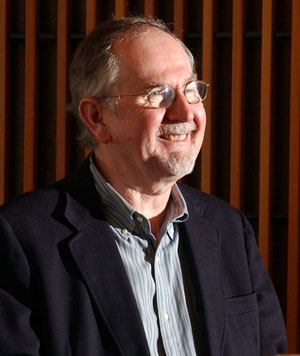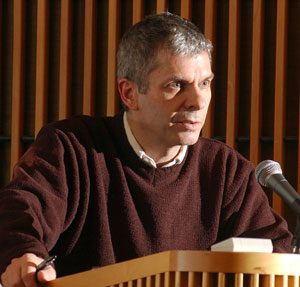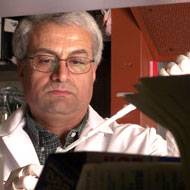
Environmental Factor, February 2008, National Institute of Environmental Health Sciences
Inflammasome and Infection
By Robin Arnette
February 2008


In Rodbell Auditorium on January 8, 2008, NIEHS welcomed Richard A. Flavell, Ph.D., as part of the continuing 2007–2008 NIEHS Distinguished Lecture series. Flavell discussed the intricacies of innate and adaptive immunity in a lecture titled “The Inflammasome in Pathogen Recognition and Inflammation.” Principal Investigator Donald Cook, Ph.D., of the Laboratory of Respiratory Biology hosted the event.
Flavell ![]() (http://info.med.yale.edu/immuno/fac_flavell.html), a Sterling Professor and Chairman of the Department of Immunology and Professor of Molecular, Cellular and Developmental Biology at Yale School of Medicine in New Haven, Conn., has garnered many prestigious awards. Also, being a Fellow of the prestigious The Royal Society
(http://info.med.yale.edu/immuno/fac_flavell.html), a Sterling Professor and Chairman of the Department of Immunology and Professor of Molecular, Cellular and Developmental Biology at Yale School of Medicine in New Haven, Conn., has garnered many prestigious awards. Also, being a Fellow of the prestigious The Royal Society ![]() (http://royalsociety.org/), the United Kingdom’s National Academy of Science, allows him to use the post-nominal letters “FRS” and share membership with British citizens who have made significant contributions to mathematics, engineering and medicine. One of the most famous Fellows is world-renowned physicist Stephen Hawking, Ph.D.
(http://royalsociety.org/), the United Kingdom’s National Academy of Science, allows him to use the post-nominal letters “FRS” and share membership with British citizens who have made significant contributions to mathematics, engineering and medicine. One of the most famous Fellows is world-renowned physicist Stephen Hawking, Ph.D.
Flavell laid the groundwork of his talk by saying, “We are very much outnumbered by microorganisms in this world, and several of those microorganisms have worked out ways of living in and on us.” However, the immunological implications of this concept depend on the exact location of the bacterium or eukaryotic parasite. For example, Microbacterium tuberculosis, the organism that causes tuberculosis, lives inside a cellular vesicle called a macrophage. The immune system has to use different ways of dealing with those organisms than it would with microorganisms that live outside of cells. Some agents, such as listeria bacteria and viruses, live in a cell’s cytoplasm rather than within a vesicle.
Mammals have three classes of molecules that detect infections, with the transmembrane Toll-like receptor class being the most well-known. The class of cytoplasmic NOD-like receptors (NLRs) is the most numerous, however. Flavell focused on three of its members: NALP3, IPAF and ASC. In addition to having leucine-rich repeats, they have nucleotide binding domains which are generally believed to be involved in pathogen recognition. “This pathogen recognition leads to an activating multi-enzyme complex called an inflammasome,” he said. “We wanted to study the proteins that make up an inflammasome to find out what they did.”
Previous studies suggested that Toll-like receptors recognized a foreign invader and transferred the signal to the cytoplasmic NLRs. The NLRs formed the inflammasome and activated caspase-1 which led to the secretion of cytokines, including interleukin-1 (IL-1), i.e., IL-1β and IL-18, and cell death. Flavell and colleagues studied NALP3 knockout mice and determined that these mutants lacked caspase-1 activity and failed to secrete IL-1. IPAF knockout mice were also defective in caspase-1 activity. These data confirmed that NALP3 and IPAF were integral players in the formation of the inflammasome.
Inflammasomes are also important in triggering adaptive immunity and may be demonstrated using a system called contact hypersensitivity in which chemicals are painted on the skin of a mouse. This action leads to a T-cell mediated immune response that can be re-challenged several days later by painting a different area of the mouse, traditionally the ear. Using a caliper a researcher can measure the thickness of the ear which indicates inflammation. The reaction is specific to the stimulus or hapten. According to Flavell the nonsensitized mouse doesn’t get a thick ear, but treating a normal wild-type mouse produces a thickening of the ear. “When this is done on the ASC knockout or the NALP3 knockout, the thickening is greatly reduced,” he said. “So this intracellular recognition mechanism through the production of IL-1 plays a role in triggering adaptive immunity.”
Flavell’s lab will continue to apply molecular approaches to understand the immune response. Despite his group’s progress, Flavell concluded, “The challenge is establishing the mechanisms by which this all works.”
"Durham Careers..." - previous story ![]()
![]() next story - "Evolution of Human..."
next story - "Evolution of Human..."



